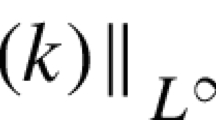Abstract
A Blasius laminar boundary layer and a steady turbulent boundary layer on a flat plate in an incompressible fluid are considered. The spectral characteristics of the Tollmien—Schlichting (TS) and Squire waves are numerically determined in a wide range of Reynolds numbers. Based on the spectral characteristics, relations determining the three–wave resonance of TS waves are studied. It is shown that the three–wave resonance is responsible for the appearance of a continuous low–frequency spectrum in the laminar region of the boundary layer. The spectral characteristics allow one to obtain quantities that enter the equations of dynamics of localized perturbations. By analogy with the laminar boundary layer, the three–wave resonance of TS waves in a turbulent boundary layer is considered.
Similar content being viewed by others
REFERENCES
Y. S. Kachanov, “Physical mechanisms of laminar-boundary-layer transition,” Annu. Rev. Fluid Mech., 26, 411–482 (1994).
E. U. Repik and Yu. P. Sosedko, “Investigation of the intermittent ow structure in the near-wall region of a turbulent boundary layer,” in: Turbulent Flows (collected scientific papers) [in Russian], Nauka, Moscow (1974), pp. 172–184.
S. K. Robinson, “Coherent motions in the turbulent boundary layer,” Annu. Rev. Fluid Mech., 23, 601–639 (1991).
A. V. Boiko, G. R. Grek, A. V. Dovgal', and V. V. Kozlov, Origination of Turbulence in Near-Wall Flows [in Russian], Nauka, Novosibirsk (1999).
D. J. Benney and H. L. Gustavsson, “A new mechanism for linear and nonlinear hydrodynamic instability,” Stud. Appl. Math., 64, 185–209 (1981).
V. A. Zharov, “Variant of description of the weakly nonlinear dynamics of the wave packet in the boundary layer on a at plate in an incompressible fluid,” Tr. TsAGI, No. 2523 (1993).
V. A. Zharov, “Wave theory of a developed turbulent boundary layer,” Uch. Zap. TsAGI, 17, No. 5, 28–38 (1986).
S. L. Gorelov, V. A. Zharov, and Y. I. Khlopkov, “The kinetic approaches to the turbulence description,” in: Rarefied Gas Dynamics, Proc. of the 20th Int. Symp. (Beijing, China, August 19-23, 1996), Peking Univ. Press, Beijing (1997).
V. A. Kader and A. M. Yaglom, “Laws of similarity for near-wall turbulent ows,” VINITI, Moscow (1980), pp. 81–155. (Itogi Nauki Tekh., Ser. Mekh. Zhidk. Gaza, 15.)
A. J. Musker, “Explicit expression for the smooth velocity distribution in turbulent boundary layer,” AIAA J., 17, No. 6, 655–657 (1979).
M. A. Gol'dshtik and V. N. Shtern, Hydrodynamic Stability and Turbulence [in Russian], Nauka, Novosibirsk (1977).
L. M. Mack, “A numerical study of the temporal eigenvalues spectrum of the Blasius boundary layer,” J. Fluid Mech., 73, 497–520 (1976).
T. Sadatoshi, “Visual observation on the ampli_cation of arti_cial disturbances in turbulent shear flows,” Phys. Fluids, 26, No. 10, 2801–2806 (1983).
V. S. Sadovskii, N. P. Sinitsyna, and G. I. Taganov, “Numerical study of the mathematical model of the near-wall flow in a turbulent boundary layer,” in: Near-Wall Turbulent Flow [in Russian], Part 1, Nauka, Novosibirsk (1975), pp. 94–116.
Author information
Authors and Affiliations
Rights and permissions
About this article
Cite this article
Dodonov, I.G., Zharov, V.A. & Khlopkov, Y.I. Localized Coherent Structures in the Boundary Layer. Journal of Applied Mechanics and Technical Physics 41, 1012–1019 (2000). https://doi.org/10.1023/A:1026694203776
Issue Date:
DOI: https://doi.org/10.1023/A:1026694203776



